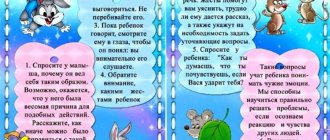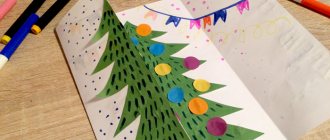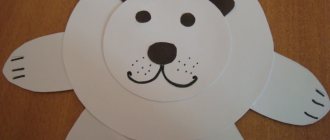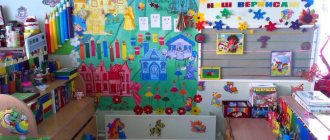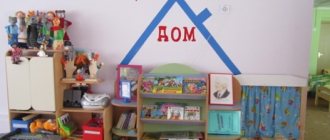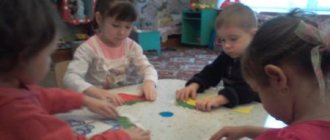Developmental subject-spatial environment in a nursery group
Galina Sarafanova
Developing subject-spatial environment in a nursery group
Developmental subject-spatial environment in a nursery group.
Corner for speech development
Equipment and materials: didactic visual materials, subject and plot pictures , book corners with age-appropriate literature; "Wonderful bag"
with various
objects .
Equipment and materials: smooth and ribbed boards, mats, massage paths with tracks (for the prevention of flat feet, a gymnastic stick, balls, a basket for throwing swords, hoops, a skipping rope, skittles, cubes, a bench, a long and short cord, bags with weights (150 -200 gr., ribbons, flags.
Art activity corner
Equipment and materials: easel, sets of colored pencils, sets of felt-tip pens, gouache, watercolors, colored wax crayons, thin and thick brushes, bristly, squirrel brushes, jars for washing brush lint from paint, drawing paper of various formats, napkins made of highly absorbent fabric water to dry the brush; foam sponges, hand wipes; plasticine, boards for modeling, oilcloth for covering tables, crayons
Equipment and materials: plastic construction sets with various methods of fastening parts (it is advisable to use 2-3 new ones during the year), construction kits with parts of different shapes and sizes, soft modules, large and small boxes, drawers, waste material: logs, cylinders, cubes, blocks with drilled holes, small toy characters (kittens, dogs, etc., cars, for playing with. Materials for manual labor: various types of paper (colored, corrugated, napkins, cardboard, postcards, etc.)
;
cotton wool, foam rubber, textile materials (fabric, ropes, laces, ribbons, etc.)
; wire in a colored sheath; natural materials, tools: scissors with blunt ends, brush, glue.
Equipment and materials: tabletop theater, screen and sets of puppets (finger, flat, etc., theater made by the teacher (cones with nozzle heads, masks, scenery, dramatization theater - ready-made costumes, masks for acting out fairy tales, homemade costumes
Equipment and materials: a bookcase, a table and two chairs, a soft sofa, a screen separating the corner from the areas of outdoor games, books according to the program, children’s favorite books, baby books, toy books, albums for viewing: “Professions”, “ Seasons”, “Kindergarten”, etc.
Equipment and materials: indoor plants with wide dense leaves, watering can, sticks for loosening the soil
Corner of role-playing games
Equipment and materials: doll furniture for the room and kitchen, attributes for playing “House”
,
“Shop”
,
“Hairdresser”
,
“Hospital”
, sailors, drivers, large dolls (35-40 cm,
medium (25-35 cm, dolls girls and boys, toy wild and domestic animals, sets of kitchen and tea utensils, set vegetables and fruits, large and medium-sized cars, trucks and cars, telephone, steering wheel, scales, bags, buckets, iron, hammer, doll strollers, fun toys with effect depending on the action (tumbler, pecking chickens, fighting sheep, jumping frogs and etc., clothes for dressing up.
Corner of educational games
Equipment and materials for sensory and mathematics:
1. Large mosaics, volumetric inserts of 5-10 elements, prefabricated toys, pyramids (of 6-10 elements, lacing, games with modeling and substitution elements, lotto, paired pictures, printed board games.
2. Non-traditional material: closed containers with slots for filling with various small and large items , large buttons or abacus seeds for stringing.
3. Carpet, typesetting, magnetic board.
4. A set of geometric shapes, objects of various geometric shapes, counting material with Velcro
5. Various small figures and non-traditional materials (cones, acorns, pebbles)
for the account.
6. Matryoshka dolls (of 5-7 elements, insert boards, insert frames, a set of colored sticks (5-7 of each color)
.
7. Split (folding)
cubes with
subject pictures (4-6 parts)
.
8. Sectional subject pictures , divided into 2-4 parts (vertically and horizontally)
.
Materials on the development of speech and cognitive activity:
1. Sets of pictures of domestic animals, wild animals, animals with babies, birds, fish, trees, flowers, vegetables, fruits, food, clothing, dishes, furniture, transport, household items .
2. Sets of subject pictures for sequential grouping according to different characteristics (purpose)
3. A series of 3-4 pictures to establish the sequence of events (fairy tales, social situations)
.
4. Series of 4 pictures: parts of the day (activities of people in the immediate environment)
.
5. Series of 4 pictures: seasons (nature and seasonal activities of people)
.
6. Large format narrative pictures with various themes
Equipment and materials: a set of noise boxes, sounding toys, contrasting in timbre and nature of sound production (bells, drum, rubber tweeters, rattles, musical educational games.
Equipment and materials: traffic lights, canvas depicting roads, pedestrian crossings, transport, models of houses, trees, road signs, figures of people and animals
This is a place where a child can sit, think, dream, remember pleasant feelings, communicate with loved ones and family, look at something, listen to something pleasant and useful, play with toys.
Locker room and booth materials in the locker room
Equipment and materials: lockers with identification (bright pictures, benches, “algorithm”
the process of dressing, stands for parents, a constantly updated exhibition of children's work, information, recommendations for parents on organizing children's leisure time
Developing subject-spatial environment in the first junior group The issue of organizing the subject-development environment of a preschool educational institution is particularly relevant today.
What is connected with the introduction of the new Federal State Educational Standard for Educational Education? B. Developing subject-spatial environment in an early age group “ “ List of components of the RPPS:: 1 Tambourine 2 Noisemakers 3 Drum 4 Rattle. Subject-spatial developmental environment in a group Organization of a developmental subject-spatial environment in light of the requirements of the Federal State Educational Standard Educational environment is a set of conditions, purposefully. Subject-spatial developmental environment in the group Subject-spatial developmental environment in the group. The group environment is designed to provide opportunities for the child.
Developmental subject-spatial environment in the preparatory group In our kindergarten it is very interesting!
We would like to conduct a tour for you all together. We open the doors to a fairy tale, And invite you to our group. Developing subject-spatial environment in the middle group of preschool educational institutions The term subject-developing environment denotes a methodically well-organized system of material objects involved in activities. Developing subject-spatial environment in the senior group Developing subject-spatial environment in the senior group. A developing environment is needed in order to raise a successful, independent person. Developing subject-spatial environment in the second junior group Developing subject-spatial environment in the second junior group by educational area “There is no such aspect of upbringing, understood. Developing subject-spatial environment in the senior group Authors: Barinova V. P., Chernyavskaya N. F., Slobodyanskaya E. I., Bronnikova O. L. Developing subject-spatial environment in the senior group .
Source
